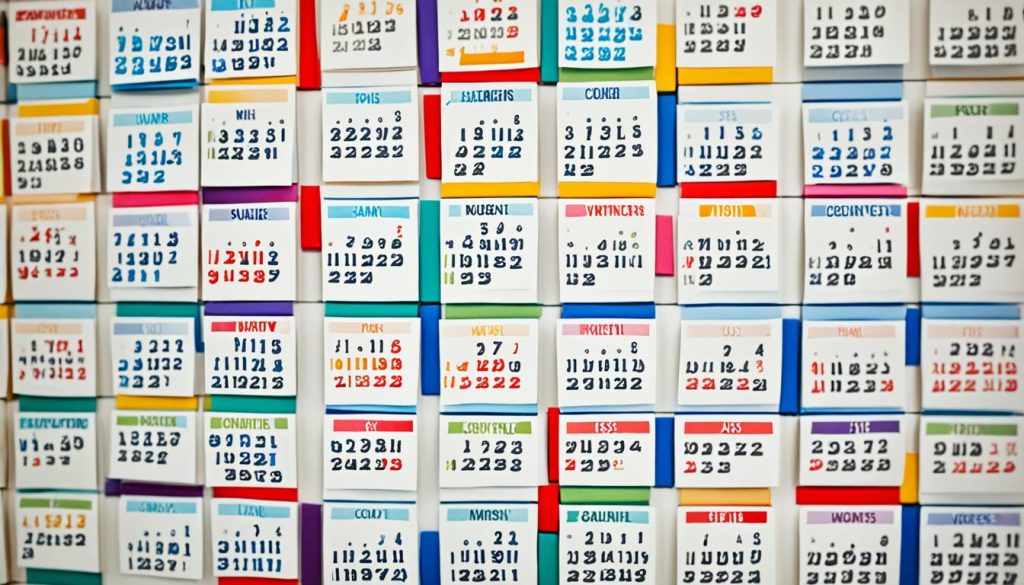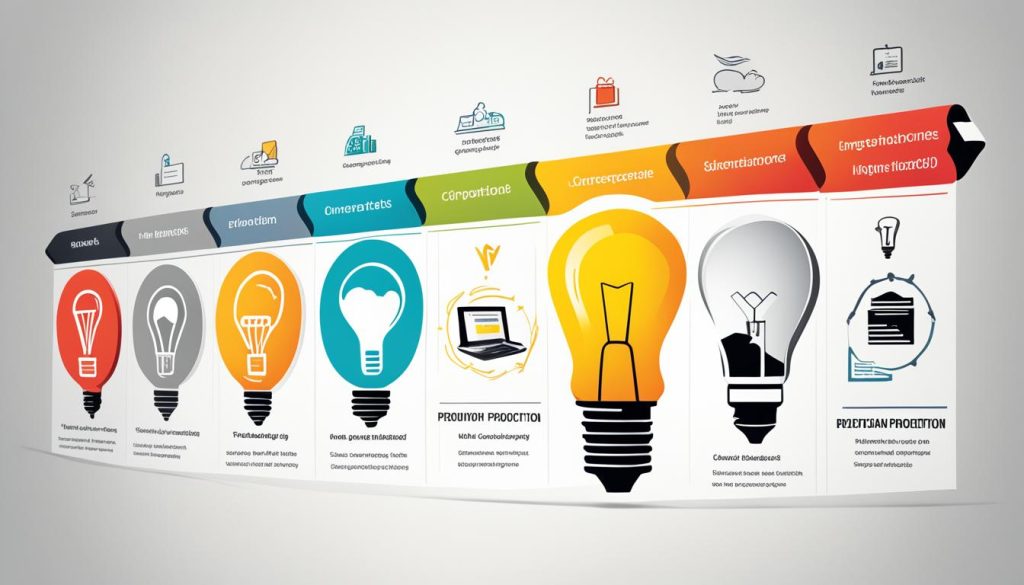Have you ever found yourself scrambling to come up with new blog post ideas? You end up publishing content that feels disjointed and haphazard. If so, it’s time to consider using a content calendar for your blog.
Did you know that businesses with a documented content strategy are 13 times more likely to see a positive return on their marketing investment?
A content calendar changes the game for your blogging workflow. It helps keep your content on-brand and engaging. By planning your editorial calendar, you’ll spend less time wondering what to write. And more time creating high-quality, valuable content for your audience.
Define Your Content Goals
Before you start making your content calendar, it’s key to define your content goals. These goals will shape who, where, and how often you share content. Make sure your team knows these goals well before and during planning.
Understand the Purpose of Your Content
First, figure out the purpose of your content. Is it to teach your audience, bring more visitors to your site, or boost brand awareness? Knowing this will help you make a focused and effective content plan.
Align Content with Business Objectives
After setting your content’s purpose, align it with your business aims. Your content should help achieve your business goals, like boosting sales, making customers more loyal, or reaching more people. This way, your content will help your business succeed.
| Content Goal | Purpose | Alignment with Business Objectives |
|---|---|---|
| Educate Customers | Provide valuable information to build trust and position your brand as an industry expert | Improve customer loyalty and increase sales by demonstrating your expertise |
| Drive Website Traffic | Attract new potential customers to your website through search engine optimization and social media promotion | Increase lead generation and conversion rates to drive business growth |
| Build Brand Awareness | Increase visibility and recognition of your brand to reach a wider audience | Expand your customer base and open up new market opportunities |
By setting clear content goals, understanding what your content is for, and linking it to your business goals, you can make a content calendar that really works. It will help your organization succeed.
Choose the Right Content Management Tool
Making a good content calendar doesn’t have to be hard. There are many content management tools out there to make it easier. You can start with a simple spreadsheet if you want.
One big plus of a content calendar is working with your team. It should let everyone add their ideas and updates. For instance, Google Sheets is free and lets your team work together easily.
When picking a content management tool, think about what your team needs. There are lots of content calendar tools and editorial calendar software out there. Look at your team’s size, budget, and how complex your content is to find the best fit.
| Tool | Key Features | Pricing |
|---|---|---|
| Google Sheets | Customizable templates, real-time collaboration, easy sharing | Free |
| Trello | Visual board-based organization, task management, integration with other tools | Free basic plan, paid plans starting at $5/user/month |
| Notion | Versatile workspace, customizable templates, database management | Free basic plan, paid plans starting at $4/user/month |
The content management tool you pick should match your team’s way of working. It should make your content creation and sharing smoother. With the right content calendar tools, your content strategy will stay on track, efficient, and effective.

Implementing a content calendar for blogs
Keeping up with a regular blogging schedule can be tough. But, using a content calendar can make it easier. It helps you plan your blog posts and keeps them on schedule. This way, you stay organized and work well with your team.
A content calendar lets you keep track of your blog’s creation process. It helps you meet deadlines, update old posts, and promote your work well. It’s a key spot for all your blog tasks, helping you stick to a schedule and meet your blog content planning goals.
| Benefits of Using a Blog Content Calendar | Key Features to Consider |
|---|---|
|
|
Using an editorial calendar for blogs can change your content marketing game. It keeps you on top of your blog content planning. This way, your blog stays a go-to spot for your audience.

Select Relevant Content Channels
Choosing the right content channels is key for your marketing strategy. Your customers might be on social media or industry publications. Know where they hang out to pick channels that reach and engage them well.
Identify Your Target Audience
Before making content, figure out who you’re talking to. Think about their age, interests, and what they need. This way, you can make content just for them.
Leverage Multiple Content Formats
Using different content formats can boost your impact. Besides blogs, try infographics, videos, or podcasts. This mix helps you reach more people and meet their learning styles.
- Explore social media platforms like LinkedIn, Twitter, and Instagram to share your content
- Contribute to industry-relevant blogs or publications as a guest writer
- Create short, informative videos to showcase your expertise
- Produce a podcast series to provide valuable insights in an audio format
- Develop eye-catching infographics to convey complex information in a visually appealing way
It’s important to select content channels and leverage content formats that speak to your audience. This way, you’ll share your message well and connect deeply with your customers.

Plan Your Content Cadence
Creating a successful content strategy is more than just making new content. It’s key to think about your cadence. Choosing the right blog content frequency and publishing schedule is crucial. It helps keep your audience interested and brings more traffic to your site.
When planning your content, consider what you can handle. Making content takes time and effort. So, pick a publishing pace that fits you and your team. Setting too high a pace might lower your content’s quality. Not publishing enough could lose your audience’s interest.
To find the right balance, think about these things:
- Your industry and audience – Look at how often competitors publish and what your audience expects.
- Your team’s bandwidth – How much time and resources do you have for making content?
- Your content goals – What do you want to achieve with your content, and how often do you need to publish to meet those goals?
By planning your content cadence well, you can make a publishing schedule that keeps your audience hooked. It also makes sure your team can keep up. This approach maximizes your content’s impact and helps your business succeed.

Create a Content Production Timeline
Creating engaging content needs a clear content production timeline. By dividing the content creation process into steps, your team stays on track. This makes your content efforts more efficient.
Break Down Content Creation into Steps
For big or complex content projects, list all steps in your calendar. Set deadlines for each task, like data collection, writing, design, and review.
Here are the steps for a detailed content production timeline:
- Research and data collection
- Content outlining and planning
- Writing and editing
- Visual asset creation (e.g., images, graphics, videos)
- Content optimization for search engines (SEO)
- Internal review and approval
- Scheduling and publication
- Promotion and distribution
Planning these tasks ahead keeps you on track with the content creation process. It’s especially helpful when working with a team. Each person handles different parts of the content.
| Task | Deadline | Assigned To |
|---|---|---|
| Research and data collection | April 1 | Jane Doe |
| Content outlining and planning | April 5 | John Smith |
| Writing and editing | April 15 | Jane Doe, John Smith |
| Visual asset creation | April 20 | Sarah Lee |
| Content optimization for search engines (SEO) | April 22 | Dave Wilson |
| Internal review and approval | April 25 | Marketing Team |
| Scheduling and publication | April 30 | Jane Doe |
| Promotion and distribution | May 1 | Social Media Team |

Incorporate Timely and Evergreen Content
When making your content calendar, it’s key to mix timely content and evergreen content. Timely content talks about what’s hot in your field right now. Evergreen content stays useful and interesting over time.
Adding both timely content and evergreen content to your calendar keeps your audience engaged. Evergreen content is great when you’re running late, as it can be made and shared anytime.
| Timely Content | Evergreen Content |
|---|---|
| Focuses on current trends and industry discussions | Remains relevant and useful regardless of date |
| Helps you stay attuned to your audience’s immediate needs | Can be created and published at any time |
| Provides a sense of urgency and freshness | Serves as a reliable fallback when your schedule faces delays |
By mixing timely and evergreen content in your calendar, you make sure your audience gets great info from you all the time.
Leverage Existing Content Assets
Building your content calendar doesn’t mean starting from zero. Your organization likely has many valuable assets that can be used again. From customer data to old blog posts, these resources can be used to leverage existing content, repurpose content, and update old content.
Repurpose and Update Old Content
Look through your archives for content that’s still useful for your audience. This might include:
- Blog posts that can be refreshed with new information or a different format
- Webinars or videos that can be broken down into a series of social media posts
- Whitepapers or reports that can be adapted into a set of infographics
Byrepurposingandupdatingold content, you can make it fresh and reach more people. Just make sure the info is up-to-date and still relevant for your audience.
| Content Type | Repurposing Opportunities | Update Considerations |
|---|---|---|
| Blog Posts |
|
|
| Webinars |
|
|
| Whitepapers |
|
|
By leveraging existing content assets, repurposing them in new ways, and updating older content, you can get more value from your content library. This way, you can keep delivering relevant, high-quality material to your audience.
Establish a Review and Approval Process
When making your content calendar, it’s key to set up a clear content review process and content approval workflow. Decide who will check each piece of content before it goes live. This might be your marketing team, experts, legal, or others. Having a set way to approve content ensures quality and keeps your schedule on track.
To make your content review process smoother, follow these steps:
- Find out who needs to look at your content.
- Set clear rules and deadlines for reviews.
- Use a tool or platform to manage reviews and approvals.
- Make sure feedback and changes are shared and tracked.
- Keep checking and improving your review process with your team’s input.
A strong content approval workflow helps keep your content top-notch. It lets you fix issues early and make sure your content meets your goals and brand.
Remember, a well-planned content review process and content approval workflow are key. They help you make consistent, quality content that speaks to your audience and supports your marketing plan.
Schedule Content Promotion
Creating a great content calendar is just the start. To really make your content shine, you need a solid promotion plan. This means sharing your content on social media platforms and working with influencers to reach more people.
Leverage Social Media Platforms
Social media is key for getting your content seen by more people. Decide how you’ll share your blog posts, videos, and other stuff on sites like Facebook, Instagram, Twitter, LinkedIn, and others. Try out different ways, like text, images, and short videos, to see what your audience likes best.
Collaborate with Influencers
Working with influencers or experts in your field can open up new audiences and add trust to your content. Contact influencers who fit your brand and look for chances to promote your content together, like guest posts, social media mentions, or making content together.
| Social Media Platform | Promotion Tactic | Potential Reach |
|---|---|---|
| Live video, image post, link share | High | |
| Carousel post, Stories, Reels | High | |
| Tweet, thread, video share | Medium | |
| Thought leadership post, video upload | High (for B2B) |
By using social media promotion and influencer collaboration in your content plan, you can greatly increase your content’s reach and engagement. This will help drive more traffic and conversions for your business.
Monitor and Analyze Performance
Using a content calendar is more than just planning and scheduling. It lets you monitor content performance and analyze content metrics. By tracking your content, you learn what works and what doesn’t. This helps you improve your strategy.
A content calendar is a key place to check all your past content. It shows you page views, engagement, and conversions for each piece. By looking at these numbers often, you can spot trends that help plan your future content.
For example, you might find that how-to guides or expert interviews get more attention. This info helps you make your content mix better. You can focus on what your audience likes most.
Also, tracking performance shows you what content needs updating. Maybe an old blog post is still popular but outdated. Refreshing it can make it valuable again for your readers.
By always monitoring content performance and analyzing content metrics, you make smart choices for your content strategy. This way, your content stays relevant, engaging, and meets your business goals.
Continuously Optimize Your Content Strategy
Your content calendar is a powerful tool, but it’s not a set-it-and-forget-it solution. To get the most value from your content plan, you need to continuously review your performance data and make changes to your content strategy. This might mean changing how often you post, trying out new formats, or adjusting your topics based on what your audience likes and engages with.
Regularly optimizing your content strategy helps you deliver the most relevant and impactful information to your target customers. By optimizing your content strategy, you can make your content calendar more effective and drive better results for your business.
A successful content strategy is an ongoing process. Stay flexible, responsive, and always be ready to adjust your approach based on what your audience needs and prefers. Continuous content strategy refinement is key to keeping your content calendar impactful.

